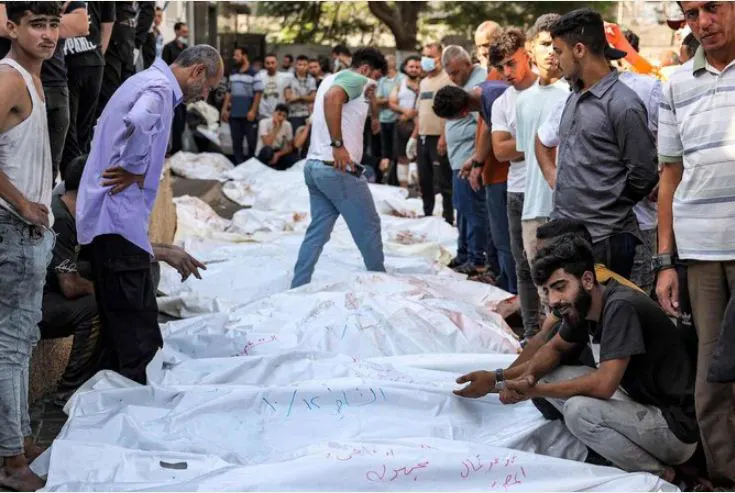The morgue at Gaza’s biggest hospital overflowed as bodies came in faster than relatives could claim them on the sixth day of Israel’s heavy aerial bombardment on the territory of 2.3 million people. With scores of Palestinians killed each day in the Israeli onslaught after an unprecedented Hamas attack, medics in the besieged enclave said they ran out of places to put remains pulled from the latest strikes or recovered from under the ruins of demolished buildings.
The morgue at Gaza City’s Shifa hospital can only handle some 30 bodies at a time, and workers had to stack corpses three high outside the walk-in cooler and put dozens more, side by side, in the parking lot.
“The body bags started and just kept coming and coming and now it’s a graveyard,” Abu Elias Shobaki, a nurse at Shifa, said of the parking lot. “I am emotionally, physically exhausted. I just have to stop myself from thinking about how much worse it will get.”
Nearly a week after Hamas militants crossed through Israel’s highly fortified separation fence and killed over 1,200 Israelis in a brutal rampage, Israel is preparing for a possible ground invasion of Gaza for the first time in nearly a decade. A ground offensive would likely drive up the Palestinian death toll, which already has outpaced the past four bloody wars between Israel and Hamas.
Already, the sheer volume of human remains has pushed the system to its limit in the long-blockaded territory. Gaza’s hospitals are poorly supplied in quiet times but now Israel has stopped the water flow from its national water company and blocked even electricity, food and fuel from entering the coastal enclave.
“We are in a critical situation,” said Ashraf Al-Qidra, the spokesman for the Gaza Health Ministry. “Ambulances can’t get to the wounded, the wounded can’t get to intensive care, the dead can’t get to the morgue.”
Lines of white body bags – soles of bare feet sticking out from one, a bloodied arm from another – brought the scale and intensity of Israel’s retaliation on Gaza into sharp relief.
Israel’s campaign on Gaza has leveled entire neighborhoods, killing over 1,400 people – over 60 percent of them women and minors, according to the Gaza Health Ministry. More than 340,000 have been displaced, or 15 percent of Gaza’s population.
The Israeli military says it is striking Hamas militant infrastructure and aims to avoid civilian casualties — a claim that Palestinians reject.
Those deaths, and over 6,000 injuries, have overwhelmed Gaza’s health care facilities as sup-plies dwindle.
“It is not possible, under any circumstances, to continue this work,” said Mohammad Abu Selim, the general director of Shifa. “The patients are now on the streets. The wounded are on the streets. We cannot find a bed for them.” After the heavy bombing of the Shati refugee camp just north of Gaza City along the Mediterranean coast on Thursday, a new wave of people streamed into the hospital complex – toddlers with bruises and bandages, men with makeshift tourniquets, young girls with blood caked on their faces.—APP










